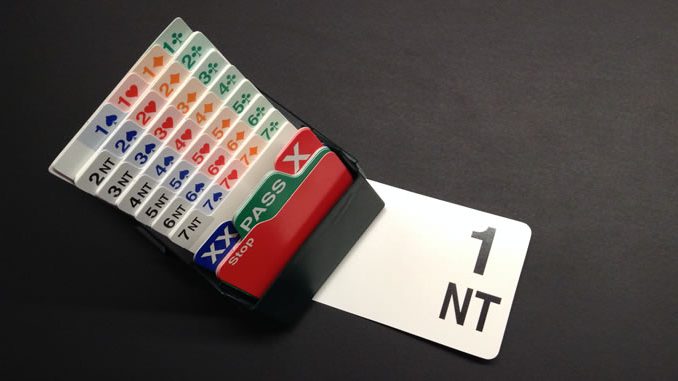
Defences against strong 1NT opening and weak 1NT opening by a panel of american experts. in English only
Eric Kokish
 Eric Kokish is one of the best bidding theoreticians in the world. He has coached many high-level teams and is a regular contributor to the Bridge Bulletin and Bridge World magazines. Kokish’s favorite approach after an enemy 1NT opening (15 to 17 HCP) is this: (see below) Kokish said, “The upside of this approach is that it gets most hand types described, and it gets the relative lengths of the two-suiters straight. The downside is that you can’t play a one-suited minor hand at the two level.” Another drawback is something that pertains to many 1NT defenses, namely, the unavailability of a penalty double because double is assigned a conventional meaning.”The loss of the penalty double is a problem across the board.
Eric Kokish is one of the best bidding theoreticians in the world. He has coached many high-level teams and is a regular contributor to the Bridge Bulletin and Bridge World magazines. Kokish’s favorite approach after an enemy 1NT opening (15 to 17 HCP) is this: (see below) Kokish said, “The upside of this approach is that it gets most hand types described, and it gets the relative lengths of the two-suiters straight. The downside is that you can’t play a one-suited minor hand at the two level.” Another drawback is something that pertains to many 1NT defenses, namely, the unavailability of a penalty double because double is assigned a conventional meaning.”The loss of the penalty double is a problem across the board.
.
It has prompted some people to start opening hands with 1NT that are either offshape or out of range since they know you can’t nail them.” Kokish referred to this approach as “modified Woolsey,” but he has also heard it called “Multi- Landy” because the 2![]() and 2
and 2![]() calls in this system resemble those conventions. (Players are reminded not to use conventional names when explaining methods to the opponents.) Against weak 1NT openings, Kokish changes his approach to incorporate a penalty double: “You can’t give up the penalty double when the opponents are playing a weak notrump,” said Kokish. “But you lose the length inferences available in the strong notrump defense.” A passed hand, however, can use the first method, according to Kokish.
calls in this system resemble those conventions. (Players are reminded not to use conventional names when explaining methods to the opponents.) Against weak 1NT openings, Kokish changes his approach to incorporate a penalty double: “You can’t give up the penalty double when the opponents are playing a weak notrump,” said Kokish. “But you lose the length inferences available in the strong notrump defense.” A passed hand, however, can use the first method, according to Kokish.
Published in Bulletin N°1
Against strong 1NT opening
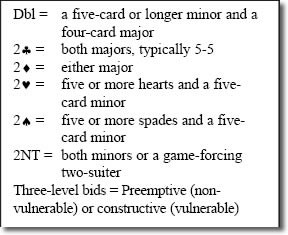
Against weak 1NT opening
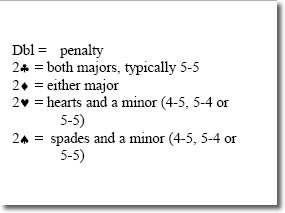
Bobby Wolff

Bobby Wolff has been a longtime champion of simple, direct systems, and his career is testimony to the fact that one doesn’t need conventional complexity in order to win.”Against expert competition, simple is best. Even something like Landy (2![]() shows the majors,all else is natural) is fine. Unusual systems typically have only one benefit: surprise. Against less experienced players, however, weird systems can work very well, but that doesn’t mean it’s good bridge,” Wolff said. Overcalling 1NT is an inherently dangerous business, according to Wolff, not only because of the risk of being penalized, but because of the difficulty of having a constructive auction. “The lengths of the overcaller’s suit(s) are unknown, so it’s easy for bad things to happen.”
shows the majors,all else is natural) is fine. Unusual systems typically have only one benefit: surprise. Against less experienced players, however, weird systems can work very well, but that doesn’t mean it’s good bridge,” Wolff said. Overcalling 1NT is an inherently dangerous business, according to Wolff, not only because of the risk of being penalized, but because of the difficulty of having a constructive auction. “The lengths of the overcaller’s suit(s) are unknown, so it’s easy for bad things to happen.”
Dan Morse
 Wolff and partner Dan Morse use this scheme against strong andweak 1NT openings:
Wolff and partner Dan Morse use this scheme against strong andweak 1NT openings:
“Barry Crane once analyzed his results from allowing the opponents to play 1NT and discovered that he was scoring something like 52 to 53%,” said Wolff. “When his side balanced against 1NT, however, (and some of the balancing actions were clearly not sound) he found that his percentage increased to 57 or 58%. Forcing his (typically) less experienced opponents to use their judgment worked to his advantage, but again, using dangerous bidding approaches just to stir up action against weaker opponents isn’t good bridge. Certainly, that approach is a reality in matchpoint games for pairs that are trying to win, but it’s not sound.” Wolff said that all partnerships need to weigh the merits of their approach, especially regardingcomplexity and aggressiveness. “Using complex systems, you’re trading solidity for pressure on the opponents.”
Published in Bulletin N°2
Against strong 1NT opening
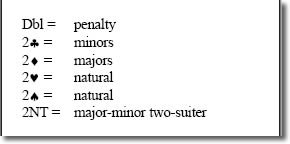
Against weak 1NT opening
Wolff’s philosophy when competing against weak 1NT openings is that it’s better to err on the side of aggression by competing.”When you have a good 13 or 14 HCP, get in if possible. True, you could get doubled, but there are risks either way. Passing could be riskier than bidding. And to penalize you, they have to havethe methods and right type of hand to do it.”
Michael Rosenberg

Michael Rosenberg of New Rochelle NY, is acknowledged as one of the best declarers on the planet. The many–time NABC champion has strong opinions when it comes to 1NT defenses. “You have different goals depending on whether you’re playing matchpoints or IMPs. At matchpoints, your goal is to ‘get in there’ and disrupt their auction. At IMPs, your goal is to getto a game or get a good score from defeating the opponents.”Rosenberg plays two different systems, therefore, to cater to these two situations. At matchpoints: Rosenberg refers to this as the “Washington system,” after the expert players in the Washington D.C. area who use this scheme. (Note that this is the same system described in Friday’s installment by expert Eric Kokish, although he calls it something different. The bottom line is that convention names are rather unimportant.) At IMPs, Rosenberg prefers this: Both methods assume the opponents are using strong (15 to 17 HCP) 1NT openings. Against weak notrumps, Rosenberg uses the IMP setup.
.
“It’s important to have a penalty double not only against weak notrumps, but also at IMPs to protect against psyches. It can ruin your auction if they psyche 1NT and you can’t penalize them. I’ve psyched 1NT with good results several times in my career against opponents who didn’t have a penalty double available.” Rosenberg also noted that handling enemy interference after your side opens 1NT “is one of the hardest areas of bridge. You need detailed agreements with partner.”One of the topics that must be discussed, according to Rosenberg, is the meaning of double in auctions such as 1NT (by you), 2X (by LHO), Double (by partner). Whether it’s penalty or takeout may depend on the form or scoring, the vulnerability, the strength of 1NT and the nature of the interference. “The most important thing is that you and your partner are on the same page,” said Rosenberg. “And sometimes that means you have to sacrifice perfection for simplicity.”
Published in Bulletin N°3
At Matchpoint
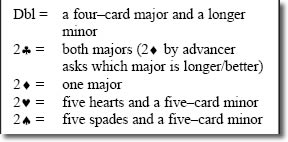
At IMPs, Rosenberg prefer this:
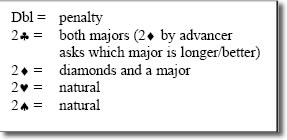
Bart Bramley
 If Bart Bramley comes to your table and says, “We play SCUM,” you shouldn’t take it personally:It’s the name of the convention he uses to compete against 1NT. The many-time NABC champ hasbeen using a variation of this treatment since 1970. SCUM is an acronym: The S stands for shape, the C stands for color and the M is for majors. (“The u’ doesn’t stand for anything. It just makes it pronounceable,” said a deadpan Bramley.) The three letters of the acronym correspond to the first three steps of the method In the case of double or 2
If Bart Bramley comes to your table and says, “We play SCUM,” you shouldn’t take it personally:It’s the name of the convention he uses to compete against 1NT. The many-time NABC champ hasbeen using a variation of this treatment since 1970. SCUM is an acronym: The S stands for shape, the C stands for color and the M is for majors. (“The u’ doesn’t stand for anything. It just makes it pronounceable,” said a deadpan Bramley.) The three letters of the acronym correspond to the first three steps of the method In the case of double or 2![]() advancer’s continuations are pass-or-correct.Bramley uses this method against strong 1NT openings, but his definition of “strong” is anynotrump range that would usually contain enough defensive strength to beat a game. “Against what I call ‘constructive’ 1NT openings, typically 12 highcard points or more, I use SCUM. Against ‘destructive’ or ‘non-constructive’ 1NT, which is anything that incorporates a bad 11 HCP or worse, I use a penalty double,” he said. The strengths of the approach appeal to Bramley.
advancer’s continuations are pass-or-correct.Bramley uses this method against strong 1NT openings, but his definition of “strong” is anynotrump range that would usually contain enough defensive strength to beat a game. “Against what I call ‘constructive’ 1NT openings, typically 12 highcard points or more, I use SCUM. Against ‘destructive’ or ‘non-constructive’ 1NT, which is anything that incorporates a bad 11 HCP or worse, I use a penalty double,” he said. The strengths of the approach appeal to Bramley.
.
“I’ve had a lot of good luck with this. The ambiguities of the system (double and 2![]() are coupled. Once you know one suit, you know the other. Other systems don’t have this. For example, in DONT
are coupled. Once you know one suit, you know the other. Other systems don’t have this. For example, in DONT ![]() is clubs and a higher suit, or in Cappelletti, 2
is clubs and a higher suit, or in Cappelletti, 2![]() hearts and a minor. There’s no connection between the lower-ranking suit and the higher one in those systems.” Bramley was candid about his competitive style versus 1NT openings. “I hate defending 1NT. I compete on some hands that would make many people blanch. My style is hyper-aggressive; I’ll come in on 4-4 hands, especially if I don’t like my lead position. If my hand contains a lot of tenaces that make it unattractive to lead from (against a 1NT opening), I’ll trade my lead problem for a declaring problem.”declaring, they’ll do so double-dummy because this method pinpoints your suits.”
hearts and a minor. There’s no connection between the lower-ranking suit and the higher one in those systems.” Bramley was candid about his competitive style versus 1NT openings. “I hate defending 1NT. I compete on some hands that would make many people blanch. My style is hyper-aggressive; I’ll come in on 4-4 hands, especially if I don’t like my lead position. If my hand contains a lot of tenaces that make it unattractive to lead from (against a 1NT opening), I’ll trade my lead problem for a declaring problem.”declaring, they’ll do so double-dummy because this method pinpoints your suits.”
Published in Bulletin N°4
Against strong 1NT opening
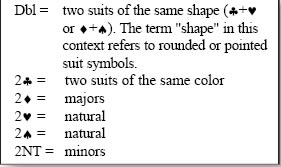
Against weak 1NT opening
Against ‘destructive’ or ‘non-constructive’ 1NT, which is anything that incorporates a bad 11 HCP or worse, I use a penalty double,” he said.
Mike Cappelletti
 Mike Cappelletti walked into the Daily Bulletin office Sunday night and said, “I see you’re running a series on notrump defenses.” We can take a hint.With the proliferation of 1NT defenses, the reputations of older systems such as Cappelletti among expert players have sometimes suffered. The newest toy is always shiniest. Cappelletti, however, continues to enjoy immense popularity with many club and tournament players who embrace it for its simplicity .The eponymous Mr. Cappelletti provided some history about the convention, as well as his views on bidding theory. “When I started playing bridge, the convention Brozel was very popular as a defense to 1NT. At the same time, however, the Kaplan- Sheinwold system was coming into vogue, and the weak 1NT it uses was robbing us blind. We needed a penalty double, but in Brozel, double showed a one-suited hand.
Mike Cappelletti walked into the Daily Bulletin office Sunday night and said, “I see you’re running a series on notrump defenses.” We can take a hint.With the proliferation of 1NT defenses, the reputations of older systems such as Cappelletti among expert players have sometimes suffered. The newest toy is always shiniest. Cappelletti, however, continues to enjoy immense popularity with many club and tournament players who embrace it for its simplicity .The eponymous Mr. Cappelletti provided some history about the convention, as well as his views on bidding theory. “When I started playing bridge, the convention Brozel was very popular as a defense to 1NT. At the same time, however, the Kaplan- Sheinwold system was coming into vogue, and the weak 1NT it uses was robbing us blind. We needed a penalty double, but in Brozel, double showed a one-suited hand.
.
So I thought ‘Why not make double for penalty, and let 2![]() show the single-suiter?'” Thus, Cappelletti was born. Its structure is this:Cappelletti is unwavering in his view that double needs to be defined as value showing and penalty oriented. “You need the penalty double. These fancy systems are giving up too much. If you have a balanced 16 or 17 points and they open 1NT in front of you, double is best in the long run. It’s like blackjack: when dealer has 10, but you have 11, you should double down. On a particular hand it might not work, but in the long run it’s best. Remember that you’re ‘over’ the 1NT opener and that you get to make the opening lead.” What about the “modified” Cappelletti convention? “I can’t stand it. Using 2
show the single-suiter?'” Thus, Cappelletti was born. Its structure is this:Cappelletti is unwavering in his view that double needs to be defined as value showing and penalty oriented. “You need the penalty double. These fancy systems are giving up too much. If you have a balanced 16 or 17 points and they open 1NT in front of you, double is best in the long run. It’s like blackjack: when dealer has 10, but you have 11, you should double down. On a particular hand it might not work, but in the long run it’s best. Remember that you’re ‘over’ the 1NT opener and that you get to make the opening lead.” What about the “modified” Cappelletti convention? “I can’t stand it. Using 2![]() to show several possible hand types is inferior to just showing your major-minor two-suiters with 2
to show several possible hand types is inferior to just showing your major-minor two-suiters with 2![]() or 2
or 2![]() . The problem with using 2
. The problem with using 2![]() as first step in modified Cappelletti is that the opponents compete over 2
as first step in modified Cappelletti is that the opponents compete over 2![]() your side could wind up losing the major.”
your side could wind up losing the major.”
Published in Bulletin N°5
Against strong 1NT opening
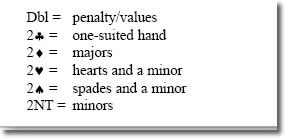
Against weak 1NT opening
According to Cappelletti, whatever the range of the opponents’ 1NT, double should show a good 14 or more. On weak notrumps, he said, “If you don’t double, but defeat 1NT by one or two tricks (plus50 or 100), you get an inferior score at matchpoints or IMPs if you could have made 1NT yourself for plus 90 or plus 120.”Also, it’s important to compete against the weak notrump (with appropriate values). If you can show both majors, you’re at a terrific advantage since your partner will have a good idea of what to do. I’ve run many, many computer simulations that show it’s right to compete with the majors even if you’re only 4-4 with hands as light as 10 or 11 high-card points.”
Brian Glubok
 The philosophy behind competitive bidding in tournament bridge has changed a great deal since the Seventies, particularly over the opponents’ strong 1NT opening. Thirty years ago, you competed if you had safety and thought there was a chance for game. Nowadays, you compete to make life more difficult for the opponents. Conventions such as DONT, Woolsey and others described in this series illustrate this sea change.This article presents a method that allows you to compete over the opponents’ 1NT opening in a maximum number of situations, with a maximum number of hand types. For simplicity and ease of memorization, I recommend you use the same method in direct and balancing position, and at matchpoints, IMPs and board-a-match teams.This method is not suitable against weak 1NT openings, for it relies upon an artificial double:
The philosophy behind competitive bidding in tournament bridge has changed a great deal since the Seventies, particularly over the opponents’ strong 1NT opening. Thirty years ago, you competed if you had safety and thought there was a chance for game. Nowadays, you compete to make life more difficult for the opponents. Conventions such as DONT, Woolsey and others described in this series illustrate this sea change.This article presents a method that allows you to compete over the opponents’ 1NT opening in a maximum number of situations, with a maximum number of hand types. For simplicity and ease of memorization, I recommend you use the same method in direct and balancing position, and at matchpoints, IMPs and board-a-match teams.This method is not suitable against weak 1NT openings, for it relies upon an artificial double:
General notes. This method will not always get you to your longest fit (sometimes advancer will pass 2T with four when there is a longer fit elsewhere) but it will allow you to compete in a maximum number of situations. This method is particularly useful in the balancing position, and when either team is not vulnerable. While the method does not need to change with the form of scoring or vulnerability, the degree of aggression may vary with these conditions. 2NT is always forcing.
.
We cannot play in 2NT when they have bid 1NT. Doubles of their artificial bids show that suit. Doubles of their natural bids are for takeout.As Larry Cohen emphasized in his articles on DONT (Disturb Opponents No Trump), the emphasis is not on getting to game, but on getting in the bidding, competing at the two level, and taking the opponents out of their comfort zone. While the opponents may occasionally double you and collect a large penalty, it is both difficult and risky for the opponents to double you at the two or three level. If the cards lie well, or you have extreme distribution, you will make your doubled partscore. This will more than compensate for the occasional penalty you will suffer. Most important, using this convention will make you a more difficult opponent and will be fun for you and your partner. What could be better than that?
Brian Glubok is a New York-based bridge professional and screenwriter. He is the executive producer of “The Bridge Movie,” a documentary about tournament bridge filmed at the Fall NABC in 1996. A five-time U.S. national team champion, he was also a long-time partner of the late Edgar Kaplan
Published in Bulletin n° 6
Edgar Kaplan
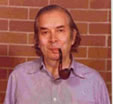
Same method in direct and balancing position, and at matchpoints, IMPs and board-a-match teams.
This method is not suitable against weak 1NT openings, for it relies upon an artificial double:
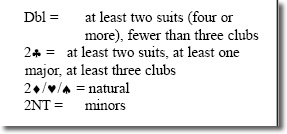
Advancer Bids
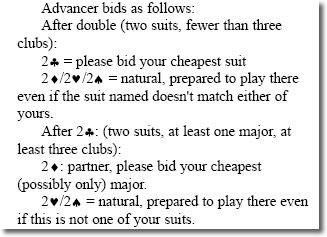
Larry Cohen
 The system I prefer and have used for more than 25 years is DONT. It was developed by my former partner, Marty Bergen.The system was initially called Bergen over Notrump but Marty also coined the acronym DONT (Disturbing Opponents No Trump), which caught on.DONT is a simple method for getting into the bidding when an opponent opens 1NT, and it is popular with many players. I used it with Marty and now with David Berkowitz. There are variations that have been invented, possibly improvements, but we prefer to keep it simple: We use this system in the direct seat and in the balancing seat. Typically, the two suits are 5–4 or 4–5 or longer either way. I like DONT because it allows you to show all one– and two–suited hands without having to bid at the three level. You always find your fit (if you have one) on the two level, which is important for following the law of total tricks.
The system I prefer and have used for more than 25 years is DONT. It was developed by my former partner, Marty Bergen.The system was initially called Bergen over Notrump but Marty also coined the acronym DONT (Disturbing Opponents No Trump), which caught on.DONT is a simple method for getting into the bidding when an opponent opens 1NT, and it is popular with many players. I used it with Marty and now with David Berkowitz. There are variations that have been invented, possibly improvements, but we prefer to keep it simple: We use this system in the direct seat and in the balancing seat. Typically, the two suits are 5–4 or 4–5 or longer either way. I like DONT because it allows you to show all one– and two–suited hands without having to bid at the three level. You always find your fit (if you have one) on the two level, which is important for following the law of total tricks.
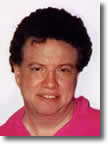 The method is very effective at matchpoints, letting you get in and disturb, safely, on manyhands. The downside is that the system is not great for identifying which of your two suits is the fivecarder,so you sometimes miss a major–suit contract, but the goal is to just get in. It also isn’t great for game bidding.I have had enough good results with DONT over the years that I wouldn’t consider changing. Suit quality and length depend on vulnerability and position. In the balancing seat, a DONT bidder can have a pretty weak hand. We presume there is no game, but if we want to ask, 2NT by advancer (the DONT bidder’s partner) asks for more information (minimum, maximum, etc.).
The method is very effective at matchpoints, letting you get in and disturb, safely, on manyhands. The downside is that the system is not great for identifying which of your two suits is the fivecarder,so you sometimes miss a major–suit contract, but the goal is to just get in. It also isn’t great for game bidding.I have had enough good results with DONT over the years that I wouldn’t consider changing. Suit quality and length depend on vulnerability and position. In the balancing seat, a DONT bidder can have a pretty weak hand. We presume there is no game, but if we want to ask, 2NT by advancer (the DONT bidder’s partner) asks for more information (minimum, maximum, etc.).
After a double, showing one suit, if you show spades, it is a good hand (no direct ![]() overcall).
overcall).
After 2![]() , partner bids 2
, partner bids 2![]() to play in the other suit.
to play in the other suit.
After 2![]() partner bid 2
partner bid 2![]() to play in the major. It is important for your partnership to discuss what happens in competition, for example, if they double the DONT bid. It is my opinion that penalty doubles of 1NT are not great. It is very hard to defend against 1NT and the double lets the opponents run to 2
to play in the major. It is important for your partnership to discuss what happens in competition, for example, if they double the DONT bid. It is my opinion that penalty doubles of 1NT are not great. It is very hard to defend against 1NT and the double lets the opponents run to 2![]()
![]() , contracts they can’t reach without the penalty double.That said, we do not use DONT against weak 1NT openings. You do need a penalty double in that situation. Against weak 1NTs we use the following, but have no strong feelings about the best method: Published in Bulletin n°7
, contracts they can’t reach without the penalty double.That said, we do not use DONT against weak 1NT openings. You do need a penalty double in that situation. Against weak 1NTs we use the following, but have no strong feelings about the best method: Published in Bulletin n°7
Against strong 1NT opening

Against weak 1NT opening
That said, we do not use DONT against weak 1NT openings. You do need a penalty double in that situation. Against weak 1NTs we use the following, but have no strong feelings about the best method:
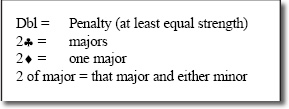
Mel Colchamiro
 Today’s expert is Mel Colchamiro, who has a different perspective on this topic.
Today’s expert is Mel Colchamiro, who has a different perspective on this topic.
During the NABC, the Daily Bulletin has featured various methods for competing when an opponent opens a strong 1NT. They are all good, although we have seen there is a difference of opinion about which method is best. One common thread, however, is that most experts believe it pays to come in aggressively directly over a strong 1NT opener. I agree. It is not the purpose of this article to argue for one method over another.
I wish to cover a more fundamental question: On what types of hands should one enter the auction after a 1NT opener? I have developed a guideline that will help you answer this question. I call it Mel’s Rule of 8. At the very least, it is an effective guide to “get you into the ball park.
Paul Soloway
![]() A K J 7 3
A K J 7 3 ![]() Q 8 2
Q 8 2 ![]() Q 7 K
Q 7 K ![]() 6 5 and heard Brazil’s Roberto Mello open 1NT(15-17) on his right. Did Soloway bid or pass? Mel’s Rule of 8 suggests a pass: eight cards in the two longest suits minus seven losers equals one, so pass is recommended despite the 15 HCP and nice spade suit. Soloway did indeed pass and defeated 1NT two tricks. Soloway had not heard of the Rule of 8, but he did what it suggests nonetheles
6 5 and heard Brazil’s Roberto Mello open 1NT(15-17) on his right. Did Soloway bid or pass? Mel’s Rule of 8 suggests a pass: eight cards in the two longest suits minus seven losers equals one, so pass is recommended despite the 15 HCP and nice spade suit. Soloway did indeed pass and defeated 1NT two tricks. Soloway had not heard of the Rule of 8, but he did what it suggests nonetheles
Here is another example from the Silver Ribbon Pairs at this tournament earlier in the week. With a strong 1NT opener on his right, a player held a hand something like
![]() Q 7 6
Q 7 6 ![]() A K 3
A K 3 ![]() A 10 6 5 4
A 10 6 5 4 ![]() 8 5 and entered the auction with a natural bid of 2♦. The result was a doubled contract and a score ofminus 800, what he deserved. With a five-card suit and a flat hand, he should have opted for defense.If you use the Rule of 8, it will tell you when and when not to bid over their 1NT, and you will avoid disasters of this type.
8 5 and entered the auction with a natural bid of 2♦. The result was a doubled contract and a score ofminus 800, what he deserved. With a five-card suit and a flat hand, he should have opted for defense.If you use the Rule of 8, it will tell you when and when not to bid over their 1NT, and you will avoid disasters of this type.
Published in Bulletin n°8
On what types of hands should one enter the auction after a 1NT opener? I have developed a guideline that will help you answer this question. I call it Mel’s Rule of 8.
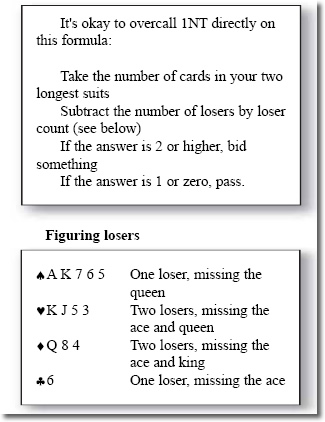
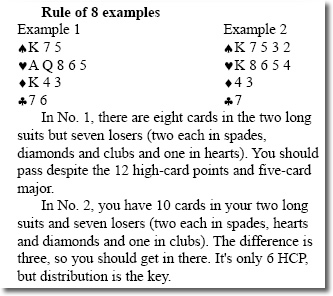
Jerry Helms
 Today’s expert is Jerry Helms from Charlotte NC. Helms, like many top players, loves to
Today’s expert is Jerry Helms from Charlotte NC. Helms, like many top players, loves to
compete over the opponents’ opening 1NT. Before he created HELLO, he disliked having to double or bid 2![]() with one suit. After experimenting with various methods, he, along with co-inventor Bill Lohmann, came up with HELLO (the name is formed from the first initials of their surnames).The weakness of many methods is that they can’t bid 2
with one suit. After experimenting with various methods, he, along with co-inventor Bill Lohmann, came up with HELLO (the name is formed from the first initials of their surnames).The weakness of many methods is that they can’t bid 2![]() or 2
or 2 ![]() directly,” said Helms. “This gives the opponents free rein at the two level.They can bid Stayman or make a transfer bid.
directly,” said Helms. “This gives the opponents free rein at the two level.They can bid Stayman or make a transfer bid.
When we created HELLO, addressing this was our first priority.“When you own a major,especially spades,you want to be able to bid it immediately for thepreemptive effect,” Helms said. “We want tointerfere, but also bid accurately when it is our hand. The whole idea is to be constructively obstructive. HELLO gets your partner involved.”Helms points out other advantages of his system. In certain HELLO auctions, the unknown
hand, the partner of the one who bid, will be the declarer. This happens when you bid 2![]() to transfer to hearts, for example.
to transfer to hearts, for example.
.
The partner accepts the transfer and “He might have something crazy such as a low doubleton heart and a six-card club suit or just about anything,” said Helms. The strong hand is on lead and has no idea of the strength or distribution of the declarer. The hand with hearts will be exposed as dummy, but the defenders already have an idea of that hand. The same situation is true when the intervener bids 2![]() and passes the 2
and passes the 2![]() response or when he bids 2NT and the partner bids 3
response or when he bids 2NT and the partner bids 3![]() . There are other auctions in which the partner may be the declarer. After a 2
. There are other auctions in which the partner may be the declarer. After a 2![]() bid for the majors, the partner will prefer spades roughly half the time. After 3
bid for the majors, the partner will prefer spades roughly half the time. After 3![]() for the minors, the partner will sometimes bid 3
for the minors, the partner will sometimes bid 3![]() . In these cases, the strong 1NT hand is the opening leader and the unknown hand remains hidden. In the passout seat the methods change slightly. Double is not as valuable as penalty since the doubler is not on lead against 1NT. Instead the double is a relay to 2
. In these cases, the strong 1NT hand is the opening leader and the unknown hand remains hidden. In the passout seat the methods change slightly. Double is not as valuable as penalty since the doubler is not on lead against 1NT. Instead the double is a relay to 2![]() . Over the 2
. Over the 2![]()
Pass = ![]()
2![]() = diamonds and a major
= diamonds and a major
2![]() = hearts and clubs
= hearts and clubs
2![]() =spades and clubs
=spades and clubs
Will these bids, your minor is five cards or longer, but the major is only four-cards long. Hands such as these are particularly hard to bid accurately, and this approach is an attempt to address that. Players who don’t like to play a double as penalty in the direct seat could use this scheme instead.“I prefer the penalty double,” said Helms. “It comes up more than you think, and is definitely needed against the weak 1NT.”
Published in Bulletin n°9
The system can be used against either weak or strong 1NT since the double is not needed to show one of the hand types.

